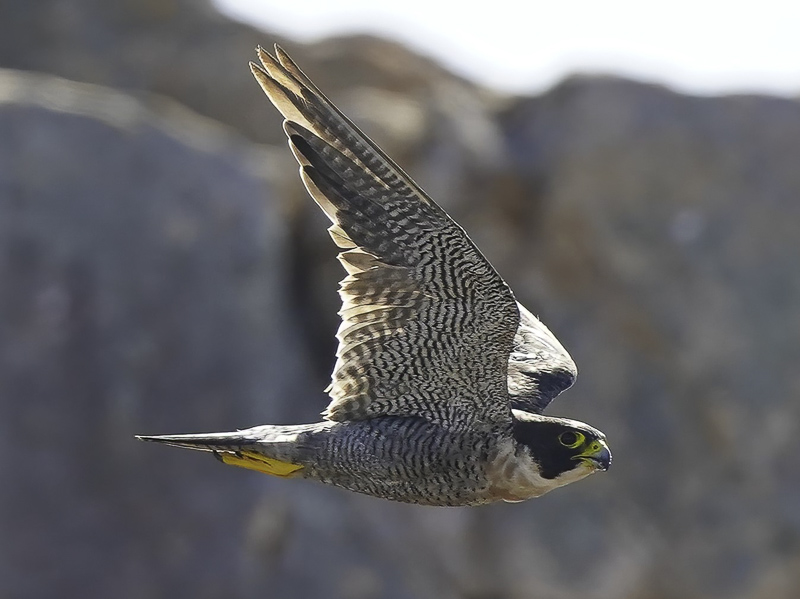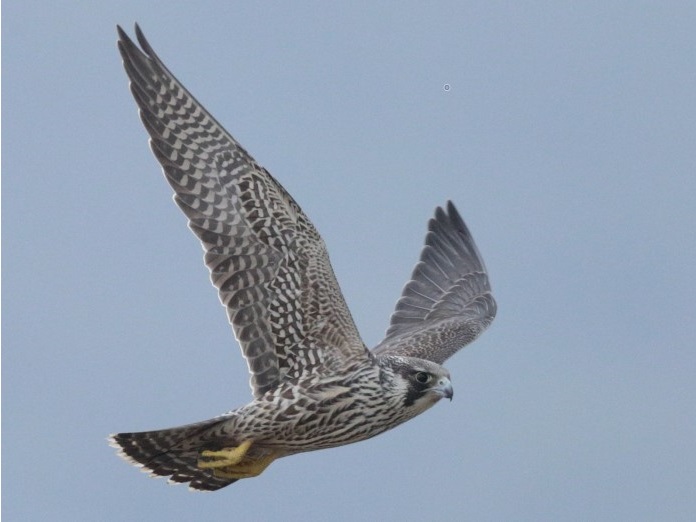Peregrine Falcon Falco peregrinus 遊隼
Category I. Present all year, with the resident subspecies peregrinator breeding and birds from northerly breeding populations present in winter.
IDENTIFICATION

Aug. 2019, Kinni Ho. Adult F. p. peregrinator.
36-58 cm. (female larger than male). Largest falcon in HK, though in structure fairly compact. Wings broader than Eurasian Hobby and more pointed than those of Common Kestrel. Adults of the resident form have dark grey upperparts, black crown with broad moustachial (that may impart a hooded appearance), white throat, dark bars on flanks and underwing coverts and spots on the belly (males are less barred below). Juveniles are dark brown above with narrow pale fringes to feathers and have heavily dark streaked buff underparts and a duller cere.

Oct. 2017, John and Jemi Holmes. Juvenile, non-resident taxon.
Winter visitors of one of the northerly taxa are larger and longer-winged. Adults have narrower moustachial stripes, larger white cheeks, and are paler and less marked below, especially on chest. Juveniles such as this are dark brown above with pale crown and pale fringes to feathers, and pale buff below with less obvious streaking.

Feb. 2024, Paul Leader. Adult, non-resident taxon.
Compared to the locally-breeding birds, adults of the northerly taxa have narrower moustachial stripes, larger white cheeks, and are paler and less marked below, especially on the chest.
VOCALISATIONS
Pairs of the local taxon can be quite vocal as they interact, especially early in the breeding season, as in the following recording.
DISTRIBUTION & HABITAT PREFERENCE
Peregrine Falcons are occur at a wide variety of coastal, inland and urban habitats, including tidal mudflats, gei wai, fish ponds, marshes, rocky coastlines, islands, grassland, shrubland, agricultural land, reclamations, tall buildings in dense urban areas and occasionally also forests. The greatest concentration of sightings is from Deep Bay where birds are often noted preying on the duck, wader and gull flocks during the winter and spring passage periods.
The breeding bird survey of 1993-96 recorded Peregrine in 1.7% of 1km squares, while the corresponding figure in 2016-19 was 0.8%. The decline occurred in the northeast and northern New Territories. There was little change across the two winter period surveys, however. Distribution in both seasons was concentrated in the southeast facing coastal areas and the central and northern New Territories.
Analysis of records during four three-year periods when reporting of this species was consistently good (1958-60, 1968-70, 1975-77 and 1995-97) indicates that Peregrine Falcon declined as an urban species in Kowloon and HK Island from the 1970s.
OCCURRENCE
Peregrine Falcons are recorded throughout the year at widespread localities, with both resident and migratory populations occurring. Figure 1 indicates that fewer birds occur in summer, with numbers dropping at the beginning of May and rising again from the third week of September; however, the relative change in numbers is probably exaggerated due to lower levels of observer activity during the hot summer months. Further, based on reports of birds showing characters of migrants from the north, it appears that the number of winter visitors is not as large compared to the local resident population as the chart might indicate.
Most reports refer to one to two birds, with three occasionally reported. An apparent steady increase in total numbers historically is thought attributable to a corresponding rise in observer activity, and a large increase in the percentage of reports from Deep Bay is no doubt also due to this.
After being observed near Hong Kong by Swinhoe (1861), Peregrine Falcon was regarded as fairly common in winter here by Vaughan and Jones (1913) and as occurring in the summer months by later authors (Aylmer 1932, Herklots 1953, Dove and Goodhart 1955, Walker 1958).
BREEDING
Breeding was first suspected at Lion Rock in 1936 (Lewis 1936) and was confirmed in 1969 when a nest on a small island in Tolo Harbour was found to contain three eggs on 7 March. Two young, approximately one week old, were noted on 7 April (Murton 1970). Also nests on buildings (e.g., approximately 56th floor of Manhattan Heights, Kennedy Town in 2022), from where birds can take advantage of feral Rock Dove populations in the area. Aerial display flights have been noted between February and May.
BEHAVIOUR, FORAGING & DIET
Frequently seen hunting birds, especially pigeons, ducks and shorebirds, and occasionally also bats, both small and large. Prey items identified are Chinese Pond Heron, Little Egret, Common Teal, Chinese Francolin, Curlew Sandpiper, Black-tailed Godwit, Common Redshank, Common Greenshank, Wood Sandpiper, Saunders’s Gull, Black-headed Gull, Bridled Tern, Budgerigar Melopsittacus undulatus, Feral Pigeon, Oriental Turtle Dove, Spotted Dove, Little Swift, White-throated Kingfisher, Black-capped Kingfisher, Barn Swallow, Chinese Bulbul, Red-whiskered Bulbul, Eurasian Tree Sparrow, Black-collared Starling and Crested Mynah. It has also been recorded hunting at night (Feare et al. 1995).
Usually seen in ones or twos. Pairs can be seen in winter and early spring circling each other followed by stoops, chasing or grappling of feet. Single birds disturbing the roosting or foraging flocks of shorebirds in Deep Bay can be a feature of the spring migration or winter periods.
RANGE & SYSTEMATICS
Worldwide breeding distribution largely between 45oN and 75oN; some populations resident, others migrate to wintering areas in southern North America, southern South America, sub-Saharan Africa, southeast Europe east through the Indian subcontinent to Indochina and east Asia and south to Australia (White et al. 2020). Occurs through much of China except for high altitude areas in the west (Liu and Chen 2020).
Polytypic. The locally-breeding resident subspecies F. p. peregrinator breeds from the Indian subcontinent to south and east China. Migratory subspecies also occur, however, and most of these are presumed to be F. p. calidus, which breeds from Lapland to northeast Siberia and is listed as a winter visitor to areas south of the Yangtze by Cheng (1987). Other taxa that could occur include F. p. japonensis, which breeds in northeast Siberia and Japan, and possibly even F. p. pealei, which breeds from the Aleutians to southwest Canada. In China several subspecies are said to occur by Liu and Chen (2020): peregrinator, calidus, japonensis, peregrinus, ernesti, babylonicus and peregrinoides.
CONSERVATION STATUS
IUCN: Least Concern. Population trend increasing.
Figure 1.

Aylmer, E. A. (1932). The birds of Hong Kong. Part IX. Order Accipitres (Falcons, Kites, Buzzards, Eagles, Hawks, etc.). Hong Kong Naturalist 3: 3-5.
Cheng, T. H. (1987). A Synopsis of the Avifauna of China. Science Press, Beijing.
Dove, R. S. and H. J. Goodhart (1955). Field observations from the Colony of Hong Kong. Ibis 97: 311-340.
Feare, C. J., D. J. Haskell and J. R. Allan (1995). Peregrine and Tree Sparrow feeding at night. Hong Kong Bird Report 1994: 218-219.
Herklots, G. A. C. (1953). Hong Kong Birds. South China Morning Post, Hong Kong.
La Touche, J. D. D. (1931-34). Handbook of the birds of Eastern China Vol. 2. Taylor and Francis, London.
Lewis, C. J. L. (1936). Notes and comments. Ornithology. Hong Kong Naturalist 7: 203.
Liu, Y. and Y. H. Chen (eds) (2020). The CNG Field Guide to the Birds of China (in Chinese). Hunan Science and Technology Publication House, Changsha.
Murton, R. K. (1970). Peregrine Falcon breeding in Hong Kong in 1969. Hong Kong Bird Report 1969: 40-41.
Swinhoe, R. (1861). Notes on the ornithology of Hong Kong, Macao and Canton, made during the latter end of February, March, April and the beginning of May 1860. Ibis 1861: 23-57.
Vaughan, R. E. and K. H. Jones (1913). The birds of Hong Kong, Macao and the West River or Si Kiang in South-East China, with special reference to their nidification and seasonal movements. Ibis 1913: 17-76, 163-201, 351-384.
White, C. M., N. J. Clum, T. J. Cade, and W. G. Hunt (2020). Peregrine Falcon (Falco peregrinus), version 1.0. In Birds of the World (S. M. Billerman, Editor). Cornell Lab of Ornithology, Ithaca, NY, USA. https://doi.org/10.2173/bow.perfal.01
Walker, F. J. (1958). Field observations on birds in the Colony of Hong Kong. Hong Kong Bird Watching Society, Hong Kong (duplicated).

